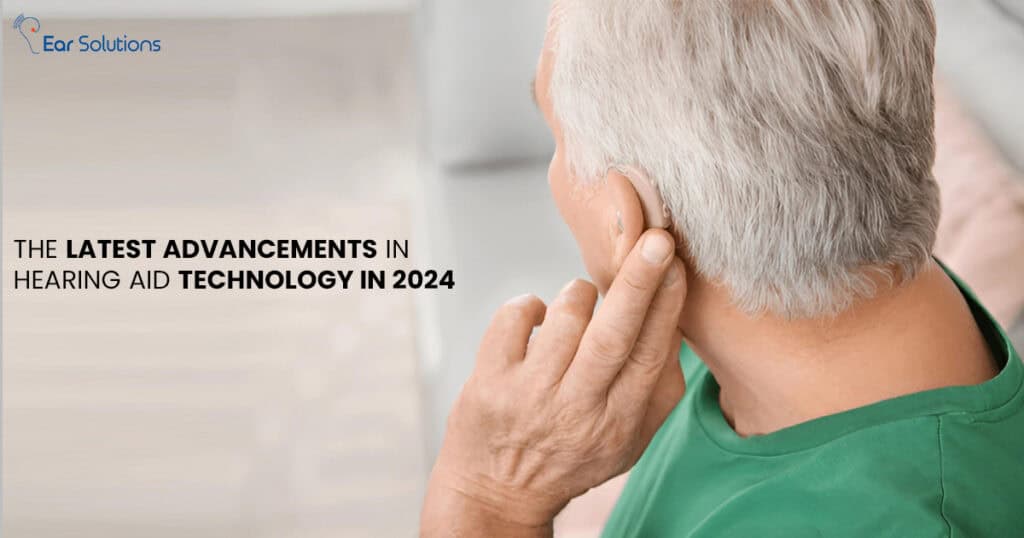The advancements in hearing aid technology have transformed the lives of many individuals. As technology keeps evolving, the hearing aid industry is becoming more promising and trustworthy. And 2024 marks another exciting year of innovation in this industry. New advancements have made hearing aids more discreet, powerful, and personalized than ever before. Whether you’re dealing with mild hearing loss or profound impairment, these technologies aim to enhance your hearing experience and improve your quality of life.
In this blog, we’ll explore the latest advancements in hearing aid technology in 2024, from AI-driven sound processing to enhanced wireless connectivity.
1. Artificial Intelligence (AI) and Machine Learning
One of the most groundbreaking advancements in 2024 is the incorporation of Artificial Intelligence (AI) and machine learning into most of the hearing aids. These technologies allow hearing aids to learn user preferences and adapt to different environments automatically.
Personalized Sound Experience: AI-powered hearing aid machines now continuously analyze your environment and adjust settings based on the type of sound and noise level. Over time, they learn your listening preferences, such as how you like to hear voices in a busy restaurant or listen to music at home. This ensures a more natural and personalized sound experience.
Automatic Sound Adjustments: AI algorithms can distinguish between background noise and speech, improving speech clarity while reducing unwanted noise. Whether you’re in a quiet room or a loud concert, your hearing aids can adjust automatically without manual input.
These intelligent systems make it easier for users to enjoy seamless hearing without constantly adjusting their devices.
2. Rechargeable Lithium-Ion Batteries with Fast Charging
In 2024, rechargeable hearing aids have become more efficient, offering longer battery life and quicker charging times. Lithium-ion batteries are now the industry standard, providing up to 30 hours of battery life on a single charge. Some hearing devices also offer fast-charging capabilities, where just a 15-minute charge can give you several hours of run.
No More Battery Replacements: With rechargeable hearing aids, users no longer have to deal with changing small disposable batteries, which can be challenging for people with dexterity issues or visual impairments.
Eco-Friendly: Rechargeable batteries reduce the environmental impact of discarded disposable batteries, making them a more sustainable choice for users concerned about their carbon footprint.
3. Bluetooth Connectivity and Streaming
Bluetooth connectivity in hearing aids has seen major improvements in 2024. These advancements allow for seamless wireless connections with smartphones, tablets, computers, and televisions.
Direct Audio Streaming: Users can stream phone calls, music, and other audio directly to their hearing aids from any Bluetooth-enabled device. This eliminates the need for external accessories and provides clearer sound quality.
Dual Bluetooth Connections: Some of the latest hearing aids allow users to connect to two Bluetooth devices simultaneously. For example, you can connect your hearing aids to both your phone and TV at the same time, switching between devices without hassle.
Enhanced Bluetooth features ensure that hearing aids function as a multi-purpose audio device, enriching the overall listening experience for users.
4. Advanced Noise Reduction and Speech Clarity
For years, ear machines have struggled to balance reducing background noise with maintaining speech clarity. The latest models in 2024 feature advanced noise reduction technologies that improve this balance significantly.
Directional Microphones: The latest hearing aid models are equipped with improved directional microphones that focus on sounds coming from the front while reducing noise from the sides and back. This enhances speech clarity, especially in noisy environments like crowded restaurants or public transport.
Speech Enhancement Algorithms: These algorithms prioritize the frequencies associated with speech while suppressing other background noise. The result is clearer conversations without overwhelming ambient sounds.
These innovations have made it easier for users to participate in conversations, even in challenging acoustic environments.
5. Tinnitus Masking and Tinnitus Relief Programs
Tinnitus, or ringing in the ears, affects millions of people worldwide. In 2024, hearing aids with built-in tinnitus masking features have become more sophisticated, offering greater relief for those affected.
Notch Therapy: Some hearing aids now feature notch therapy, a sound treatment that reduces tinnitus symptoms by neutralizing the specific frequencies associated with the ringing sound. Over time, this therapy has been shown to reduce the perception of tinnitus.
Customizable Soundscapes: Newer hearing aid devices offer a variety of soundscapes (such as ocean waves or white noise) that can mask tinnitus, providing relief and helping users concentrate or sleep more comfortably.
6. Invisible Hearing Aids and Discreet Designs
In 2024, hearing aid machines have become more discreet than ever before. Invisible or IIC hearing aids, which sit deep inside the ear canal, are virtually unnoticeable. These devices are designed for users who prefer their hearing aids to be discreet while still benefiting from advanced technology.
In-the-Ear (ITE) Designs: Some new models offer custom-fit designs that are almost invisible from the outside, providing an aesthetic advantage while maintaining top-tier performance.
Sleek Behind-the-Ear (BTE) Models: Even behind-the-ear (BTE) hearing aids have become smaller and more ergonomic, fitting snugly behind the ear without drawing attention.These advancements cater to users who may have previously been hesitant to wear hearing aids due to concerns about appearance.
7. Health Monitoring Features
Another exciting innovation in 2024 is the integration of health monitoring features into hearing aids. Some models now include sensors that track vital health metrics like heart rate, activity levels, and fall detection.
Fall Detection: Hearing aids with built-in accelerometers can detect if a user falls and automatically send an alert to emergency contacts. This is particularly useful for older adults who are at higher risk of falling.
Fitness Tracking: Hearing aids are now capable of monitoring activity levels, counting steps, and providing health insights, similar to fitness trackers or smartwatches.
By merging hearing aids with health-tracking capabilities, users benefit from a dual-purpose device that promotes both better hearing and improved overall wellness.
Conclusion
The advancements in hearing aid technology in 2024 have revolutionized how people with hearing loss experience the world. From AI-driven sound personalization to discreet designs and health-tracking features, these innovations offer a range of benefits that cater to different lifestyles and needs.
Whether you’re looking for more convenience, better sound clarity, or a device that integrates seamlessly into your digital life, the latest hearing aids are equipped with everything you need. With these advancements, hearing aids have become more than just amplification devices—they are smart, multi-functional tools that enhance the overall quality of life for users.
Consult with a hearing care professional or audiologist at Ear Solutions to determine which hearing aid technology is right for your specific needs.





